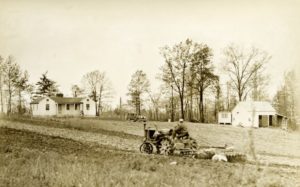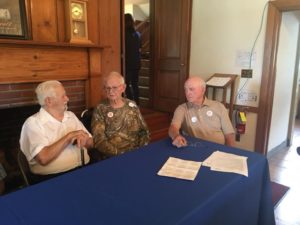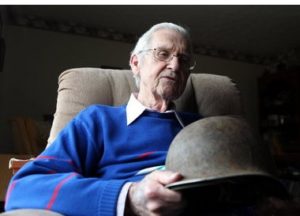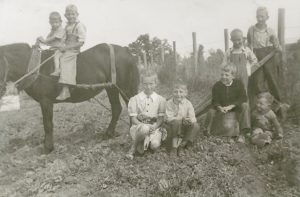By Meredith Dreistadt, AmeriCorps Member and acting archivist at Arthurdale Heritage, Inc.
This article appeared in the Volume 1, Issue 3 Winter 2020 issue of the Appalachian Curator. Click here to view a PDF of the full issue.
In the height of the Great Depression, Eleanor Roosevelt, First Lady to the newly elected President Franklin D. Roosevelt, left affluent Washington, D.C. to travel to one of the most impoverished communities in the country: the coal mining towns along Scotts Run in northern West Virginia. There she saw firsthand how horrifically affected families were by both the ripples of the Great Depression and the greed of coal companies that ruled over the miners’ lives. As soon as she returned to Washington, Mrs. Roosevelt set to work pushing for funding and devising plans for a new community to aid these desperate miners.

Out of her efforts came Arthurdale, a town built from scratch by the government in which 165 former miners and their families, called homesteaders, were given houses, jobs, education, community, and farmable land with the hope of creating financial and community stability for the group. In the 85 years that have passed since the start of the United States’ first New Deal Homestead community, the “Arthurdale Project,” is an important window into the past for its role in being the first federal housing project in the United States. It is for this reason that the grassroots-started non-profit Arthurdale Heritage, Inc. (AHI) has been active in documenting and archiving the voices of homesteaders and their descendants.
In June of 1987 volunteer historian for AHI, Glen Longacre, sat down individually with 28 original homesteaders, most of whom were in their eighties and nineties, turned on a tape recorder, and began asking them about the impact of this federal project on their lives. Charles and Hilda Hendershot were married in 1931 in Scotts Run and described their desperate situation: “We got married and lived in one of the little company shanties up against the hillside. It looked like it was about ready to fall down. We were there until we moved [to Arthurdale]. It was bad,” said Hilda. Charles affirmed the conditions in the run, “People was hungry. They wasn’t workin’, hardly workin’. I worked one, two, a really big week if I got three days. About 90% of ‘em lived out of the company store, whatever the company wanted to give ‘em or let ‘em have.”
Otis Pugh remembered moving from a coal shanty up to an Arthurdale house, “That was all the difference in the world up there after you got the new house up there at Arthurdale.” His wife, Edith Pugh agreed, “Well, that was something wonderful to us. We went up there and had heat all through the house, in all the bedrooms.” These interviews offer incredibly important insights into the lives of coal miners and their families whose lives were changed forever by the Roosevelt Administration.

It was through Longacre’s efforts to save these histories that AHI’s oral history collecting began in earnest. A series of questions were developed in the early 1990s on which all interviews since have been based. Many of our interviewees, particularly older women who worked in their homes most of their lives, will argue that they do not have much to say about Arthurdale when asked for an oral history interview. The nature of AHI’s interview questions ensures an open-ended discussion between interviewer and interviewee can be had. The prompts allow homesteader descendants to talk more freely about their experiences in Arthurdale, without the worry of value. Prompts such as “tell me about where you grew up,” “what kind of chores did you do as a child?,” and “who were your friends at Arthurdale High?” allow for stories to emerge, even from the quietest of our interviewees. Certain questions such as “did you ever meet Eleanor Roosevelt?” have been removed from the list due to the lack of discussion that usually surrounded the many “no” answers that were recorded. Instead our volunteer interviewers have discovered that if someone had met Mrs. Roosevelt, they would most certainly bring up that meeting throughout their stories on their own accord.
Over the past 35 years AHI has been devotedly documenting the Arthurdale community by collecting historic objects, photos, and papers from homesteaders and their descendants. Oral histories, however, have been collected much more inconsistently. These histories have been taken only when a member of AHI has the keen interest to do so, which leaves gaps in the Arthurdale story. Since 2015, the spark has been reignited in the form of two homesteader grandchildren, Ed and Jean Turnley, a former executive director, Jeanne Goodman, several AmeriCorps members, and many transcribers such as Carole Heaster. These volunteers have recorded dozens of oral histories, all of which are invaluable to AHI’s archival collection.
Capturing voices of Arthurdale today no longer means capturing homesteaders, as their generation has entirely passed away, but it means capturing the stories of their children and grandchildren, the people whose lives are actively impacted by the New Deal community of the 1930s. This provides a new insight to the Arthurdale Project by allowing us to discover the effects of this experimental community on entire families.

Historically, Arthurdale was a contentious project for the government to undertake. A major flaw was in homesteader employment. The job market was largely unstable for homesteaders as the industries that the government contracted to provide employment suffered once branches were placed in Arthurdale. This was due to a myriad of reasons including the poor state of the late 1930s U.S. economy and the remoteness of the work site from major trade routes. The project cost around 2.6 million dollars from taxpayers and returned virtually no significant revenue. For these reasons, Arthurdale is sometimes viewed as an overreach by the federal government.
Despite critics who claim that Arthurdale was a failure, homesteaders and their descendants will argue otherwise. In 2017, descendant Edgar Shackleford explained why he thought it was a success: “We just had a good time runnin’ around all through Arthurdale as kids. I knowed everyone back then. We didn’t have to worry about food or nothing. We worked hard at the house taking care of the gardens, but we didn’t have to worry. That’s a success to me.”
In late July of 2019, two sons of homesteaders Ross and Mildred Lyons, Donald and Raymond Lyons, were interviewed about their experiences. As a final interview question, Jean Turnley asked, “What do you think when people say Arthurdale was a failure?” Ray Lyons chuckled, “Those people clearly didn’t grow up here.”
Children of original homesteaders have their own children, grandchildren, and great-grandchildren, all of whom have been given more economic opportunities than may have been granted had their ancestors never left Scotts Run in the 1930s. Brother and husband to two homesteaders, John Wiles, argued in 2019 that Arthurdale, “brought people out of poverty and gave them something to work for. You know they worked hard before Arthurdale, but seeing the success is what gave us all (descendants) something to work for too.”

These oral histories nuance the legacy of this experimental homestead community. They provide color, emotion, and personality to an otherwise forgotten moment in the history of the Great Depression, the Roosevelts, and the beginning of federal housing projects. With an ear to its present community, AHI has continued the important work of documenting the history of this pioneering project. These tapes and their transcriptions are available to the public in AHI’s archive building in Arthurdale, West Virginia. AHI plans to create an online archive space for ease of use and access by anyone interested in the history of Arthurdale.
3 Comments
Trill Dreistadt
I loved this article! So informative, concise, beautifully researched, and sensitive to individuals and families of the era. The beautiful stories documented here capture a time in our history when impoverished people worked together as a community to prevail against desperation.
Steven Dreistadt
Having been there to visit Arthurdale and learn of its history, I was impressed by the vision and implementation of federal funds and the support of Eleanor Roosevelt. Her compassion and follow up with various programs gave meaning to the out of work coal miners in that area. This is one positive of how government should work .
Rita C.
Way to, Uncle Dick. Clarence and Elnora DeGolyer raised 13 children, 11 natural and two raised grandchildren. Every one of them spoke so highly and passionately about Arthurdale. They had everlasting gratitude for the chance to live happy lives. All of us grandchildren, great-grandchildren and great-great-grandchildren owe our lives to Arthurdale, WV.